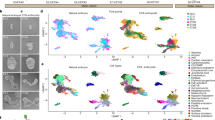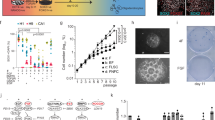Abstract
We demonstrate directed differentiation of telencephalic precursors from mouse embryonic stem (ES) cells using optimized serum-free suspension culture (SFEB culture). Treatment with Wnt and Nodal antagonists (Dkk1 and LeftyA) during the first 5 d of SFEB culture causes nearly selective neural differentiation in ES cells (∼90%). In the presence of Dkk1, with or without LeftyA, SFEB induces efficient generation (∼35%) of cells expressing telencephalic marker Bf1. Wnt3a treatment during the late culture period increases the pallial telencephalic population (Pax6+ cells yield up to 75% of Bf1+ cells), whereas Shh promotes basal telencephalic differentiation (into Nkx2.1+ and/or Islet1/2+ cells) at the cost of pallial telencephalic differentiation. Thus, in the absence of caudalizing signals, floating aggregates of ES cells generate naive telencephalic precursors that acquire subregional identities by responding to extracellular patterning signals.
This is a preview of subscription content, access via your institution
Access options
Subscribe to this journal
Receive 12 print issues and online access
$209.00 per year
only $17.42 per issue
Buy this article
- Purchase on Springer Link
- Instant access to full article PDF
Prices may be subject to local taxes which are calculated during checkout





Similar content being viewed by others
References
Bain, G., Kitchens, D., Yao, M., Huettner, J.E. & Gottlieb, D.I. Embryonic stem cells express neuronal properties in vitro. Dev. Biol. 168, 342–357 (1995).
Wichterle, H., Lieberam, I., Porter, J.A. & Jessell, T.M. Directed differentiation of embryonic stem cells into motor neurons. Cell 110, 385–397 (2002).
Mizuseki, K. et al. Generation of neural crest-derived peripheral neurons and floor plate cells from mouse and primate embryonic stem cells. Proc. Natl. Acad. Sci. USA 100, 5828–5833 (2003).
Kawasaki, H. et al. Induction of midbrain dopaminergic neurons from ES cells by stromal cell-derived inducing activity. Neuron 28, 31–40 (2000).
Lee, S.H., Lumelsky, N., Studer, L., Auerbach, J.M. & McKay, R.D. Efficient generation of midbrain and hindbrain neurons from mouse embryonic stem cells. Nat. Biotechnol. 18, 675–679 (2000).
Ying, Q.L., Stavridis, M., Griffiths, D., Li, M. & Smith, A. Conversion of embryonic stem cells into neuroectodermal precursors in adherent monoculture. Nat. Biotechnol. 21, 183–186 (2003).
Evans, M.J. & Kaufman, M.H. Establishment in culture of pluripotential cells from mouse embryos. Nature 292, 154–156 (1981).
Martin, G.R. Isolation of a pluripotent cell line from early mouse embryos cultured in medium conditioned by teratocarcinoma stem cells. Proc. Natl. Acad. Sci. USA 78, 7634–7638 (1981).
Aubert, J. et al. Screening for mammalian neural genes via fluorescence-activated cell sorter purification of neural precursors from Sox1-gfp knock-in mice. Proc. Natl. Acad. Sci. USA 100, 11836–11841 (2003).
Wood, H.B. & Episkopou, V. Comparative expression of the mouse Sox1, Sox2 and Sox3 genes from pre-gastrulation to early somite stages. Mech. Dev. 86, 197–201 (1999).
Haub, O. & Goldfarb, M. Expression of the fibroblast growth factor-5 gene in the mouse embryo. Development 112, 397–406 (1991).
Hebert, J.M., Boyle, M. & Martin, G.R. mRNA localization studies suggest that murine FGF-5 plays a role in gastrulation. Development 112, 407–415 (1991).
Aubert, J., Dunstan, H., Chambers, I. & Smith, A. Functional gene screening in embryonic stem cells implicates Wnt antagonism in neural differentiation. Nat. Biotechnol. 20, 1240–1245 (2002).
Parisi, S. et al. Nodal-dependent Cripto signaling promotes cardiomyogenesis and redirects the neural fate of embryonic stem cells. J. Cell Biol. 163, 303–314 (2003).
Finley, M.F., Devata, S. & Huettner, J.E. BMP-4 inhibits neural differentiation of murine embryonic stem cells. J. Neurobiol. 40, 271–287 (1999).
Glinka, A. et al. Dickkopf-1 is a member of a new family of secreted proteins and functions in head induction. Nature 391, 357–362 (1998).
Sakuma, R. et al. Inhibition of Nodal signalling by Lefty mediated through interaction with common receptors and efficient diffusion. Genes Cells 7, 401–412 (2002).
Pera, M.F. et al. Regulation of human embryonic stem cell differentiation by BMP-2 and its antagonist noggin. J. Cell Sci. 117, 1269–1280 (2004).
Doetschman, T.C., Eistetter, H., Katz, M., Schmidt, W. & Kemler, R. The in vitro development of blastocyst-derived embryonic stem cell lines: formation of visceral yolk sac, blood islands and myocardium. J. Embryol. Exp. Morphol. 87, 27–45 (1985).
Duncan, S.A., Nagy, A. & Chan, W. Murine gastrulation requires HNF-4 regulated gene expression in the visceral endoderm: tetraploid rescue of Hnf-4(−/−) embryos. Development 124, 279–287 (1997).
Tao, W. & Lai, E. Telencephalon-restricted expression of BF-1, a new member of the HNF-3/fork head gene family, in the developing rat brain. Neuron 8, 957–966 (1992).
Xuan, S. et al. Winged helix transcription factor BF-1 is essential for the development of the cerebral hemispheres. Neuron 14, 1141–1152 (1995).
Oliver, G. et al. Six3, a murine homologue of the sine oculis gene, demarcates the most anterior border of the developing neural plate and is expressed during eye development. Development 121, 4045–4055 (1995).
Nordstrom, U., Jessell, T.M. & Edlund, T. Progressive induction of caudal neural character by graded Wnt signaling. Nat. Neurosci. 5, 525–532 (2002).
Piccolo, S. et al. The head inducer Cerberus is a multifunctional antagonist of Nodal, BMP and Wnt signals. Nature 397, 707–710 (1999).
Ding, J. et al. Cripto is required for correct orientation of the anterior-posterior axis in the mouse embryo. Nature 395, 702–707 (1998).
Puelles, L. et al. Pallial and subpallial derivatives in the embryonic chick and mouse telencephalon, traced by the expression of the genes Dlx-2, Emx-1, Nkx-2.1, Pax-6, and Tbr-1. J. Comp. Neurol. 424, 409–438 (2000).
Hsieh-Li, H.M. et al. Gsh-2, a murine homeobox gene expressed in the developing brain. Mech. Dev. 50, 177–186 (1995).
Lazzaro, D., Price, M., de Felice, M. & Di Lauro, R. The transcription factor TTF-1 is expressed at the onset of thyroid and lung morphogenesis and in restricted regions of the foetal brain. Development 113, 1093–1104 (1991).
Lee, S.M., Tole, S., Grove, E. & McMahon, A.P. A local Wnt-3a signal is required for development of the mammalian hippocampus. Development 127, 457–467 (2000).
Galceran, J., Miyashita-Lin, E.M., Devaney, E., Rubenstein, J.L. & Grosschedl, R. Hippocampus development and generation of dentate gyrus granule cells is regulated by LEF1. Development 127, 469–482 (2000).
Gunhaga, L. et al. Specification of dorsal telencephalic character by sequential Wnt and FGF signaling. Nat. Neurosci. 6, 701–707 (2003).
Mukhopadhyay, M. et al. Dickkopf1 is required for embryonic head induction and limb morphogenesis in the mouse. Dev. Cell 1, 423–434 (2001).
Simeone, A., Acampora, D., Gulisano, M., Stornaiuolo, A. & Boncinelli, E. Nested expression domains of four homeobox genes in developing rostral brain. Nature 358, 687–690 (1992).
Ericson, J. et al. Sonic hedgehog induces the differentiation of ventral forebrain neurons: a common signal for ventral patterning within the neural tube. Cell 81, 747–756 (1995).
Chiang, C. et al. Cyclopia and defective axial patterning in mice lacking Sonic hedgehog gene function. Nature 383, 407–413 (1996).
Rallu, M. et al. Dorsoventral patterning is established in the telencephalon of mutants lacking both Gli3 and Hedgehog signaling. Development 129, 4963–4974 (2002).
Wang, H.F. & Liu, F.C. Developmental restriction of the LIM homeodomain transcription factor Islet-1 expression to cholinergic neurons in the rat striatum. Neuroscience 103, 999–1016 (2001).
Munoz-Sanjuan, I. & Brivanlou, A.H. Neural induction, the default model and embryonic stem cells. Nat. Rev. Neurosci. 3, 271–280 (2002).
Tropepe, V. et al. Direct neural fate specification from embryonic stem cells: a primitive mammalian neural stem cell stage acquired through a default mechanism. Neuron 30, 65–78 (2001).
Shirayoshi, Y., Okada, T.S. & Takeichi, M. The calcium-dependent cell-cell adhesion system regulates inner cell mass formation and cell surface polarization in early mouse development. Cell 35, 631–638 (1983).
Kim, J.H. et al. Dopamine neurons derived from embryonic stem cells function in an animal model of Parkinson's disease. Nature 418, 50–56 (2002).
Barberi, T. et al. Neural subtype specification of fertilization and nuclear transfer embryonic stem cells and application in parkinsonian mice. Nat. Biotechnol. 21, 1200–1207 (2003).
Nieuwkoop, P.D. Activation and organization of the central nervous system in amphibians. J. Exp. Zool. 120, 1–81 (1952).
Takahashi, K., Liu, F.C., Hirokawa, K. & Takahashi, H. Expression of Foxp2, a gene involved in speech and language, in the developing and adult striatum. J. Neurosci. Res. 73, 61–72 (2003).
Chang, C.W. et al. Identification of a developmentally regulated striatum-enriched zinc-finger gene, Nolz-1, in the mammalian brain. Proc. Natl. Acad. Sci. USA 101, 2613–2618 (2004).
Hirashima, M. et al. A chemically defined culture of VEGFR2+ cells derived from embryonic stem cells shows the role of VEGFR1 in tuning the threshold for VEGF in developing endothelial cells. Blood 101, 2261–2267 (2003).
Johansson, B.M. & Wiles, M.V. Evidence for involvement of activin A and bone morphogenetic protein 4 in mammalian mesoderm and hematopoietic development. Mol. Cell. Biol. 15, 141–151 (1995).
Acknowledgements
We are grateful to members of the Sasai lab and to T. Era, S. Kuratani, R. Ladher, I. Matsuo, F. Matsuzaki, H. Niwa, T. Watabe, R. Shigemoto and S. Kaneko for invaluable comments and advice on this work; to S. Nishikawa, S.-i. Nishikawa and M. Takeichi for labeled E-cadherin antibody; to A. Smith for Sox1-GFP ES cells and to N. Sasai for advice on antibody production. K.W. is thankful to S. Iwamizu-Watanabe for discussion and constant encouragement. This work was supported by grants-in-aid from the Ministry of Education, Culture, Sports, Science and Technology (Y.S., Y.W.), the Kobe Cluster Project (Y.S.) and the Leading Project (Y.S.).
Author information
Authors and Affiliations
Corresponding author
Ethics declarations
Competing interests
The authors declare no competing financial interests.
Supplementary information
Supplementary Fig. 1
Immunostaining analysis of SFEB-treated ES cell aggregates. (PDF 1190 kb)
Supplementary Fig. 2
Analysis of the effects of Wnt, Nodal and BMP antagonists. (PDF 650 kb)
Supplementary Fig. 3
Expression of primitive endodermal and mesodermal markers in SFEB. (PDF 1019 kb)
Supplementary Fig. 4
BrdU uptake and TUNEL analyses in SFEB/BMP-treated ES cells. (PDF 207 kb)
Supplementary Fig. 5
Expression of rostral-caudal markers in differentiating ES cells. (PDF 998 kb)
Supplementary Fig. 6
RT-PCR analysis and the role of E-cad function in SDIA-treated ES cells. (PDF 1086 kb)
Supplementary Fig. 7
Systematic induction of pallial and subpallial telencephalic tissues. (PDF 486 kb)
Supplementary Fig. 8
Expression of basal telencephalic markers in SFEB/Shh-induced cells and the embryonal brain. (PDF 1246 kb)
Rights and permissions
About this article
Cite this article
Watanabe, K., Kamiya, D., Nishiyama, A. et al. Directed differentiation of telencephalic precursors from embryonic stem cells. Nat Neurosci 8, 288–296 (2005). https://doi.org/10.1038/nn1402
Received:
Accepted:
Published:
Issue Date:
DOI: https://doi.org/10.1038/nn1402
This article is cited by
-
Loss of Dip2b leads to abnormal neural differentiation from mESCs
Stem Cell Research & Therapy (2023)
-
Human 3D brain organoids: steering the demolecularization of brain and neurological diseases
Cell Death Discovery (2023)
-
Machine learning-based estimation of spatial gene expression pattern during ESC-derived retinal organoid development
Scientific Reports (2023)
-
Two-dimensional Ti3C2Tx MXene promotes electrophysiological maturation of neural circuits
Journal of Nanobiotechnology (2022)
-
3D and organoid culture in research: physiology, hereditary genetic diseases and cancer
Cell & Bioscience (2022)



